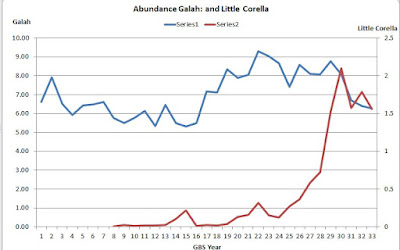As a result of that I have had two responses, from areas about 3km apart, of repeated hearings of the species. Both sites have habitat suitable for Koels so I initially believed there were two birds in the area. Following further observations from the general area I consulted with a person researching Koels and the conclusion was that this could well be one bird moving around through the day.
The presence of even a single bird for several days is still unusual as in the past most of the records of the species have come from the urban area of Canberra. A first map of this is that from the COG Bird Info facility. This is very useful as it covers the entire period in which Koels have been recorded in the area.
The sightings in the Brindabellas are interesting since there would seem to be little food for Koels up there. Otherwise it shows sightings around Canberra/Queanbeyan and Goulburn and one active cell in the Carwoola area - I presume this reflects a small number of sightings by myself.
The eBird record has a wider extent (it covers the whole world but in this case the area from Canberra East is the bit of interest). However it has only become an important facility in the past few years, so lacks the length of the COG series. It does show the big gap between the Coast and Canberra. (As an aside, I have recorded Koel quite frequently in recent Summers at Mallacoota.)
Zooming in to the eBird data shows sightings reported by me at Carwoola (including one from this morning, in orange). It also shows some 2014 sightings from a couple of sites at Bungendore and Wamboin.
Looking at Goulburn the species is reported from 5 sites.
A question of timing is also interesting. The COG page shows the records of the birds by month:
This seems to correlate fairly well with the second broods of Red Wattlebirds in the ACT (and the presence there of the fruit Koels like to eat).Much the same pattern, albeit at lower frequency, is shown in Carwoola.
The March records are interesting since they suggest a migration out of the area
In a post to the COG Chatline about the recent outbreak of sightings in Carwoola I referred to having issued a ukase about people reporting potential breeding records in this area to me. Apparently this is an unusual word but material posted about its meaning could be summarised as 'a Tsarist edict of an arbitrary nature' which pretty much covers my intention. I could have used the word 'bull' but people might just have thought that was my usual stuff rather than its use in a Papal sense.













